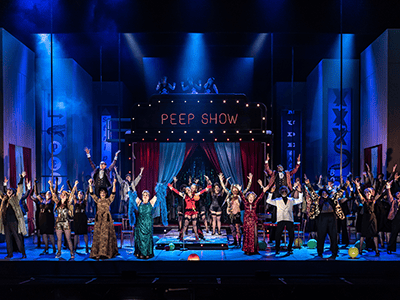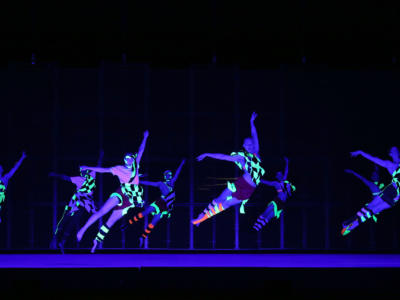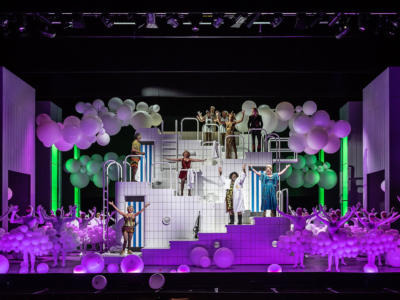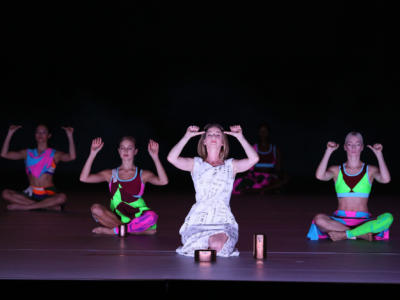ENO Response: The Mask of Orpheus reviews
21st October 2019 in News
ENO Response is a new scheme that gives aspiring journalists and reviewers the opportunity to produce opera reviews and receive writing advice and feedback.
ENO has had no editorial input in the reviews. All views are their own.
Patrick Shorrock
Harrison Birtwistle’s The Mask of Orpheus has been languishing unstaged since its premiere (also at the Coliseum) 33 years ago – albeit with a subsequent concert performance and recording. ENO have now brought it back to thrilling theatrical life in a gorgeously extravagant production (featuring 400,000 Swarovski crystals on Daniel Lismore’s jaw-droppingly opulent costumes) as the third in their season of Orpheus operas. This wonderfully confident performance – no nervous looking back here – made it very clear that this is a major opera.
Birtwistle still has a reputation for writing music that Mail and Telegraph readers are encouraged to write off as mindless cacophony, but his score is a glorious assertion of the power of music. Yes, it’s challenging in places, but that’s because of its sheer originality and variety: if anything, it contains too much music, rather than too little. It starts from a drone that emerges from nowhere, rather like the Rhinegold prelude, followed by mysterious electronic music, round which the performed music – including a wonderful range of percussion and fascinating vocal lines – weaves itself. It’s powerful and elemental, and demands your full concentration. There is momentum, structure, huge variety, and sustained theatrical tension. Yes, it’s exhausting, but that’s because it’s so utterly different from what you will hear anywhere else: sounds so fascinatingly intense that they overwhelm and exhaust, as much as they exhilarate. The sheer excess of this music’s sensory overload – especially when combined with words, drama, and dance – pushes an audience’s ability to concentrate to its very limits, but what could be more authentically operatic than that? Its Dionysian force sweeps you along to places that no other composer could take you. I defy anyone not to find the music at the end of act 2 hauntingly beautiful and poignant as Orpheus hangs himself, whilst the close of act three, with a stunning pas de deux on trapeze, was awesome in the literal old fashioned sense of the word.
Birtwistle makes things even more difficult by dividing each of the main roles into three – Man/woman, myth, and hero, with the first two sung and the latter danced – and presenting several incompatible versions of the myth at once. (The costumes were helpfully colour-coded with all those playing Orpheus in red, Eurydice in blue, and Aristaeus in green.) It’s as if he’d taken a hammer to 3 Greek vases, and then fashioned something astonishingly new with the fragments. It stretches the operatic form to its limits, but then this is what composers have always done. Birtwistle sets, I think, a dreadful example to less talented composers. But the perpetual retelling of the myth with endless variations, despite the fragmented narratives, was a truly moving depiction of a soul locked into an obsessive revisiting of memories. The clunky and ungainly words of Peter Zinovieff’s libretto seemed to revel in their obscurity and pretentiousness, and were (justifiably in my view!) not treated respectfully by the composer, who inserted arbitrary sounding pauses in the middle of the phrases.
The libretto could have been the kiss of theatrical death. That things worked so well dramatically was largely down to Daniel Kraemer’s superb production and the conviction and commitment of a formidably talented cast, led by a fearless Peter Hoare in one of the most demanding tenor roles ever written that took huge quantities of stamina, concentration and stage presence. Kraemer brilliantly turned Orpheus into an ageing rock star, with awards and guitars on the walls, red dressing gowns, and a drug habit. His production was taut and stylish, providing much needed narrative focus and clarity. He was superbly supported by Barnaby Booth’s stunning choreography (in the air and on the ground) that was beautiful to look at, as well as wonderfully expressive; Peter Mumford’s wonderfully varied film projections; Lizzie Clachan’s superbly practical and protean set; and Lismore’s astonishing costumes (the Kardashian-inspired nurses in rubber were truly terrifying). Reappearing , but visually very different, motifs from the Gluck and Offenbach versions included a suitcase, freakish costumes, babies, and video projections of the ocean, but somehow emphasised the differences between these pieces on the same theme rather than the similarities.
I’m still none the wiser about the distinction between Orpheus as hero and myth,or the point of the eponymous mask. The programme suggested that the mask solidifies and takes on an existence independent of its own creator – something probably true of most artistic creation. I found myself thinking how it seemed to go back to Monteverdi’s operatically primeval telling of the story, where Orpheus, after losing Eurydice a second time, is lifted up by his father Apollo to sing his music forever among the stars. Birtwistle also closes his opera with a wonderfully affirmatory celebration of music as a consolation for suffering that lives on after the artist’s death.
Naomi James Mitchell
This diamante daydream of an opera had it all doing on, from dystopian futuristic costume design to aerialists with abs of steel performing intricate routines (around) 10 feet above the stage. This piece is so interesting because I’m not certain as to whether I loved it or hated it.
The Mask of Orpheus is like marmite and will, in my opinion create the same cultural divide as The Rite of Spring. The composer (Harrison Birtwistle) has created controversy in this composition. I have come to decide that I am not a fan of this composition style thus the music of this opera did not appeal or emote to me. However, both Orpheus the man (Peter Hoare) and Orpheus the myth (Daniel Norman) had wonderful voices, the interweaving of their story arcs only aided in creating confusion. Then by adding a third Orpheus, the Hero (Matthew Smith) my brain was addled further. They were each paired up with a respective Eurydice (Marta Fontanals-Simmonds – the Woman), (Clare Barnett Jones – the Myth), and (Alfa Marks – the hero); the happenings going on, on stage became a cacophony of confusion.
The director (Daniel Kramer) is in no way incompetent or directed the actors in a way that can’t be understood; but the overall delivery lost the message the opera was trying to deliver. I found that there was too much happening on stage, at once to process. Each Orpheus and Eurydice pair had a specific story arc that I do believe was directed in a beautiful nuanced way, but as all three were happening at the same time, it was not possible to fully appreciate one without missing a huge chunk of another. The marvellous lighting/video designer (Peter Mumford) has surprised me in how he was able to evoke intense emotions from visuals alone; His video of bees moving in a hive was especially evocative. Mumford’s collaboration with the set designer (Lizzie Clachan) was a match made in heaven, Clachan’s contemporary open plan flat set effectively communicated the contemporary nature of this opera in a very sophisticated way.
What I found particularly interesting about this piece where the choreography in the moving boxes portraying many different myths. The choreographer (Barnaby Booth) made beautiful interpretations to the myths through dance; the dancers (Joan Aguilla-Cuevas, Sam Ford, Ripp Greatbatch, Stefano de Luca) had beautiful fluid movement qualities which contrasted greatly to what was happening on stage. However, I do not understand how these myths had any relevance to the storyline or if they were necessary to continue along the plot in the first place.
The choice to tell the myth of ‘Orpheus and Eurydice the Heroes’ through gymnastics was a good idea in my opinion. It was odd at first when you realised that this pairing of Orpheus (Matthew Smith) and Eurydice (Alfa Marks) would not be singing, though they proved why they were necessary to the plot when they started to perform. Along with ‘Aristaeus the Hero’ (Leo Hedman), the aerial displays they performed where very useful in getting to grasp on how the characters were feeling and where they were in their story arcs.
One thing about this production that was undeniably ingenious was the costume design. Costume designer (Daniel Lismore) has created costumes to die for. Not only was he able to make stunning gowns dripping with crystal elegance, but also slightly unsettling latex nurse outfits with ridiculous body proportions. Every costume Lismore created was beauty encapsulated in their own rights. Yet when all the costumes were put together the stage held so many different visual stimulants, the image became overwhelming. The use of so many crystals under the unforgiving stage lights created a kaleidoscope of colour being reflected of the many costumes, which in effect hinders the audience understanding the piece as they can’t get through the visual stimulants.
Overall, I cannot say that this piece of art was successful as an opera. I did not understand where the story was going or where it came from. I found the ending especially unneeded; it was too much. I had no idea what relevance it held to the price and felt as though the opera could have been shorter as I felt the ending gave no impact and held no meaning. The experience this opera gave me was unsettling as I never knew what was happening or where it was going. This was not one of Daniel Kramer’s best works of opera and feel as though this would have worked better as an art installation, than an opera. I found no coherence in this piece.
Nevertheless, art is dividing, and the world of opera is changing. I would like to see this again, but I think the creative team should condense the story to make it more cohesive and easier to understand.
3/5
Aine Kennedy
Anyone braving the Victoria line after 2 am must be prepared to share a carriage with rave-goers returning home while still very much under the effects of the naughty salt. Bouncing saucer-eyed and bare-breasted around the carriage, jaws working furiously as they struggle to form words, these revellers may not know it, but they bear an uncanny resemblance to the opening act of Birtwistle’s seminal The Mask of Orpheus. It is a credit to this production that one only notices the likeness of the libretto to the ramblings of a crackhead about halfway through the second act- and that this realisation just adds to the enjoyment.
The Mask of Orpheus has attained a somewhat mythic status of its own since premiering in 1986, since when, despite critical acclaim, it has been hitherto unrevived. Alongside Birtwistle’s vocal and orchestral contributions, the opera features an electronic score realised by his late collaborator, Barry Anderson, which plink-plonks away horrifically enough alongside the wild ululations of Peter Hoare as Orpheus Man and Marta Fontanals-Simmons as Euridice Woman. The overall sonic effect is one of a fractious, alien-sounding landscape, flush with timbres and orchestrations that conjure everything from the voice of Hermes to the rasping trumpet of a vaudeville act. Certainly striking, but is this repetitive, atonal, ritualistic music deserving of its ‘difficult’ reputation? ‘I actually think the music is very accessible,’ observed a Cantabrigian archly in the first interval. ‘It’s very diatonic.’ His Oxonian companion sniffed disparagingly. ‘I’m just glad that they were tuning before every act. I’d hate to hear Birtwistle out of tune.’
Such passive aggression notwithstanding, the Birtwistle is a surprising standout in ENO’s Orpheus series: a vibrantly weird yet relatively unpretentious tour de force that gathers the ridiculous, the tragic and the frankly disturbing into a crystal-slathered chokehold, and refuses to let go. Daniel Kramer’s production seizes expertly upon three millennial fetishes: camp, nostalgia, and the surreal or grotesque. Aside from counterbalancing Birtwistle’s less-than-accessible reputation, and getting some art-school bums on seats, this approach reflects the crippling uncertainty which lies at the heart of both the opera and modern society.
The theme of this year’s Met Gala confirmed ‘camp’ as the hottest trend of 2019, part of a wider wash of cultural nostalgia that is frequently ascribed to a dread of the future, instilled in 90’s babies by 9/11, climate change, and other uniquely modern issues that changed perceptions of both the world and our place in it. An attendant result of these anxieties, and the realisation that nostalgia is not a permanent solution, is the recent phenomenon of the recourse to the surreal. ‘Why is millennial humour so weird?’, asked the Washington Post in 2017, citing a slew of absurdist, violent, and nihilistic memes taking hold of the cultural consciousness.
Birtwistle’s version of the Orphic myth, more concerned with an exploration of its meaning in Western cultural memory rather than a linear retelling, is eerily prescient of this bizarrist, post-truth era. The 2010’s have been a decade of iconoclasm, as traditional sources of cultural identity, from mass media to the Presidency, have lost their authority and their rose-tinted hue- starting, aptly, with once-beloved 90s icon Bill Cosby. Like Birtwistle’s Orpheus, we are caught between increasingly divergent versions of an unclear past and an even crueller, more uncertain future. So of course, when the past can’t be trusted and the future looks bleak, the appropriate response is a conga line of bright pink google-eyed monsters, sashaying across the stage to a distant metallic clunking, and sporting, variously a labia-headdress, or a mask of the botched fresco restoration that went viral in 2012. Decadent and disturbing, the production embraces familiar images, only to completely decontextualise them. Kardashian-shaped, latex-clad nurses are swept up alongside buboe-encrusted monsters- trundled writhing onstage in a glass tank, like pestilential go-go dancers- in a spectacle that’s part Star Trek, part The Shining, with a generous dash of RuPaul’s Drag Race.
Of course, this could be a completely inaccurate interpretation. But perhaps that’s the point- although no one seems to know what exactly the opera means per se, every facet of the production is visually and intellectually stimulating enough that any viewer will have a merry three and a half hours trying to make sense of it. Does the bath represent the pools of memory and forgetfulness? Rebirth? Just an excuse to see the hunky aerialist emerge from it dripping wet and wiggling his six pack, à la 007? Who knows. But part of the joy is that it doesn’t try to tell you. The Mask of Orpheus is concerned with human anxieties so universal that the production barely needs to point them out- it can just sit back, sparkle, and let the audience project.




